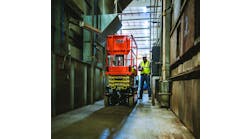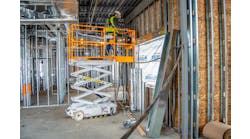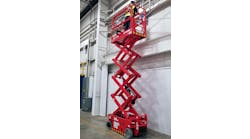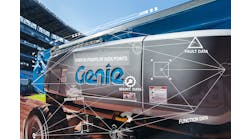As part of a series of interviews with manufacturers of aerial work platforms, RER recently spoke with George Fitchett, vice president of sales for Snorkel about equipment control systems, serviceability, the potential for growth in smaller units and safety regulations on low-level access equipment.
RER: Tell us about new technological developments on your equipment?
Fitchett: Snorkel is in the process of introducing a new control system, which is more responsive for the operator. And, critically, it is much easier for service engineers to diagnose and rectify any issues. Snorkel’s reputation is built on the reliability and durability of its aerial work platforms, so we are constantly looking at new ways to improve both these key aspects. We have already integrated the new control system into our new S Series of electric slab scissorlifts. Over the coming months, we will continue to roll it out across our product range for internal applications. Our booms remain hard-wired as this is the best solution for boomlifts.
What are some of the trends you expect to see in the coming years in aerial equipment?
Diversification is the buzz word in the rental industry. The major rental companies are all looking for revenue streams outside of construction. I think this will drive innovation on smaller, compact machines. In particular, we very firmly believe there is a huge, unexplored opportunity for low-level access. Injuries caused by falls from heights of six feet or less cause enormous personal and economic damage in North America. Lightweight “mini” scissorlifts with platform heights of up to 10 feet can really improve productivity and safety.
In terms of the rental market, we hope we may be seeing something of a recovery in the second half of this year and going into 2011. What are your expectations for the economy?
We’re not out of the woods yet! If you look at the key market indicators for construction activity in particular, there are few signs of any real improvement this year, period. Rental companies are holding onto their cash and until they see some major improvement in utilization, they have no need to invest in new aerials. I expect 2011 will herald the start of the upturn — and when it comes, I think this time it will be a much more gradual upturn than in the past.
What types of equipment do you recommend for rental fleets as we go into, hopefully, a recovery?
Snorkel recently launched the Pop-Up brand of push-around mini-scissors in North America. Pop-Up lifts deliver the productivity and safety benefits of aerial work platforms to an entirely new sector — those professions that are currently reliant on podium towers or stepladders. Pop-Up represents a superb rental opportunity — major rental companies in the U.K. have achieved full payback in little more than a year, with average utilization rates of 90 percent and above. The machines are so highly regarded that some of the largest construction contractors in Britain have now banned the use of stepladders or podiums on their job sites.
What are some of the improvements and new developments your customers have been asking for in your equipment?
Snorkel has a hard-won reputation for producing reliable, robust machines that are built to last. Almost all the customer feedback we get about product development relates to the changing landscape of aerial safety.
What are some of most important regulatory developments — in terms of aerial safety — currently and how do they play into where you are going in your technology?
In the United States, OSHA is beginning to monitor and enforce low-level access more closely. Many customers, at the recommendation of inspectors, are requiring anchorage attachments for scissor lifts, even though not required under OSHA regulations and opposed by organizations such as IPAF. This has driven us to consider anchorage attachments as standard on low-level access equipment. Although not driven heavily yet through governmental regulations, many insurance companies are recommending the removal of ladders above four feet from many worksites and facilities. This may help to drive the low-level access market even faster, as employers look for the most cost effective means to maintain compliance.
Worldwide, the new Australian standard will become effective soon — but it is so closely related to EN280 (the European standard) that I think it will help Snorkel’s global growth. It means we can build more standardized units that comply with a variety of national or regional standards.
What areas of aerial safety are you most concerned with right now and what is your company doing in the safety area?
The biggest area of aerial safety that concerns us now is the issue of fall restraints on small scissorlifts. IPAF's opposition to these is based on manufacturers’ testing and knowledge. Government mandates, based on uninformed decisions, could drive the industry into areas that create more problems than government bodies even realize. That's why we feel it is extremely important to be involved in organizations that work to recommend practices and training of personnel involved in this industry. Snorkel offers customized training on both general equipment and unique options offered by Snorkel, so that employers and employees alike feel comfortable introducing a new piece of equipment into the workplace.
What types of improvements would you most like to see when it comes to aerial work platform safety practices in the rental industry?
I think global, uniform compliance standards would be a major improvement in our industry. Manufacturers spend tremendous amounts of time customizing equipment to comply with the regulations of different countries. This time would be better spent improving and perfecting a single, harmonized piece of equipment that was acceptable anywhere. I don't however think this is close to a reality as reaching global consensus on equipment safety and safe practices is about as likely as reaching a unanimous decision in the United Nations!





